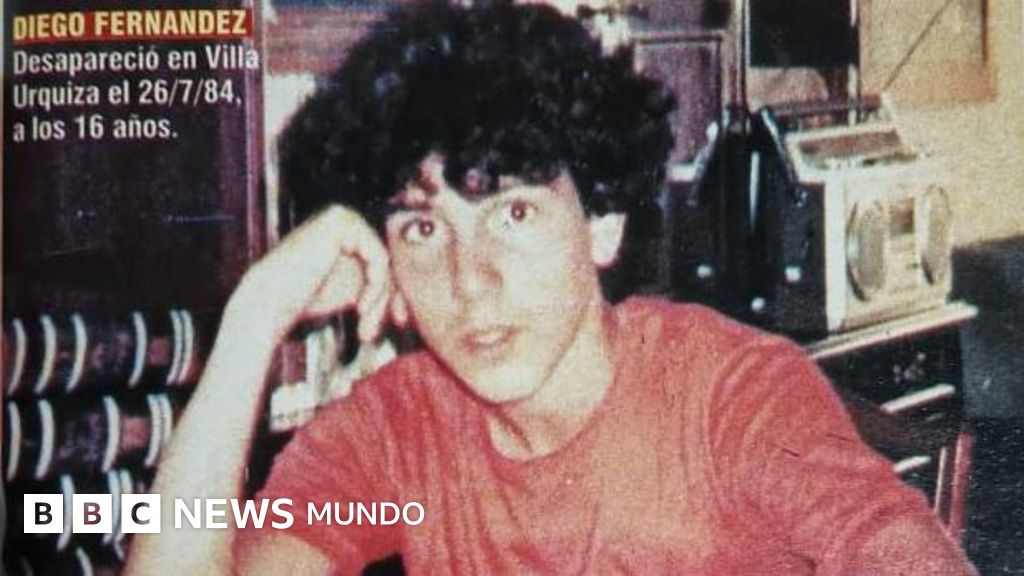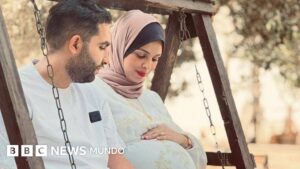

Image source, National Library/Magazine This!
-
- Author, Cecilia Barría
- Author's title, BBC News World
He left his house on July 26, 1984 at two in the afternoon. With 16 years and a tangerine in his hand, Diego Fernández said goodbye to his mother telling him that he was going to visit a friend and then to school.
But he never returned.
More than four decades later, some workers who worked last May making a wall in a house in the Caghlan neighborhood in Buenos Aires, found by chance some buried bones and gave notice to the police.
Next to the human remains, there was a casio clock with calculator, a keychain, a corbbat, a clothing label and a currency. Thanks to DNA tests, the authorities confirmed that it was the disappeared teenager 41 years ago.
The case generated great media coverage in Argentina because it was initially reported that the bone remains had been found in a house in which the singer Gustavo Cerati had lived for a while, although later it was clarified that it was the adjoining housing.
Although the crime is prescribed, the Argentine justice will investigate the cause under the figure of homicide to clarify who killed the adolescent and what was the reason.
Forensic experts assigned to the case found signs of injuries that would have been caused by a sharp object.
“There are marks on the body that correspond to a violent death and an attempt to dismembered, but it can also have to do with an attempt to manipulate the body to proceed to the burial of it,” Mariella Fumagalli, the director of the Argentine Forensic Anthropology Team (EAAF) told the Argentine press.

Image source, National Library/Magazine This!
“I grew up with very large chest pain”
Diego's mother, who is 87 today, never disconnected the phone of the house, hoping that one day her son will call her.
“Until recently, he kept looking out the window to see if Diego returned,” says Javier Fernández, brother of the missing teenager, in dialogue with BBC Mundo.
Javier remembers how hard it was for the family to live with the doubt about what happened to Diego, a prominent footballer of the Excursionist Athletic Club.
“I grew up with a very large chest pain, this has been a agony,” he explains from Buenos Aires with the broken voice.
“Diego was my idol. I was 10 years old and we played football, I kicked me penalties in the room.”
In recent days he has lived a chaotic mixture of strong emotions. When he learned of the news he could barely believe what was happening.
“I felt anger, helplessness, sadness and, at the same time, joy because I found my brother 41 years later.” The finding, he says, will allow the family at least to give him a decent burial.
“When they give me my body I can say goodbye in peace as he deserves,” he says.
“Poor, I was taken from my life, he was all that was fine for me.”

Image source, Family courtesy
The father was looking for him in the streets
Argentina magazine this! He published an article on the case in 1986, two years after the adolescent's disappearance.
In him, his father, Juan Benigno Fernández, said that in a notebook he wrote all the information that could be useful to find his son's whereabouts and that he joined press clippings.
In addition, he began to collect information about the disappearances of other children.
“Since this living misfortune happened to us from these calls that come out in the newspapers, on television and I decided to see the parents of each minor who was claimed.”
Dedicated to the sale of cars spare parts, the father reported that every time he had an intuition, he took his bicycle and went out to travel the streets in search of his son.
Until one day he died run over while trying to find Diego, his son Javier explained.
Excompañeros declare before the Prosecutor's Office
After the identification of the remains, the investigation was in charge of the prosecutor Martín López Perrando, who is currently taking statements to people who can provide relevant information of the case.
Several former partners of “El Gaita”, as Diego told Diego at school, have declared before the prosecutor in order to provide any information that could be useful to solve the case.
According to the Argentine press, the prosecutor also made a statement on Monday to Cristian Graf, Diego's partner at the National School of Technical Education (Enet), who lived in the house where the bone remains were found.
In that same house, Graf's mother still lives, local media point out.

Image source, Family courtesy
“From the school we send our condolences to their family and we accompany them respectfully in this hard moment,” Enet said in a statement.
They also expressed their condolences from the football team in which Diego played.
“The Excress Athletic Club expresses its stupor and sadness for the news about Diego Fernández Lima,” says the text published in the social network X. “We send our condolences and a big hug to his whole family.”
Innumerable solidarity samples have reached the family members of the adolescent.
His brother, who tries to contain the crying every time he remembers Diego, says that despite all the pain, the discovery of his brother's remains will help the family close a cycle after decades of uncertainty.
“It will help us to be a little more in peace.”

Subscribe here To our new newsletter to receive every Friday a selection of our best content of the week.
And remember that you can receive notifications in our app. Download the latest version and act.






